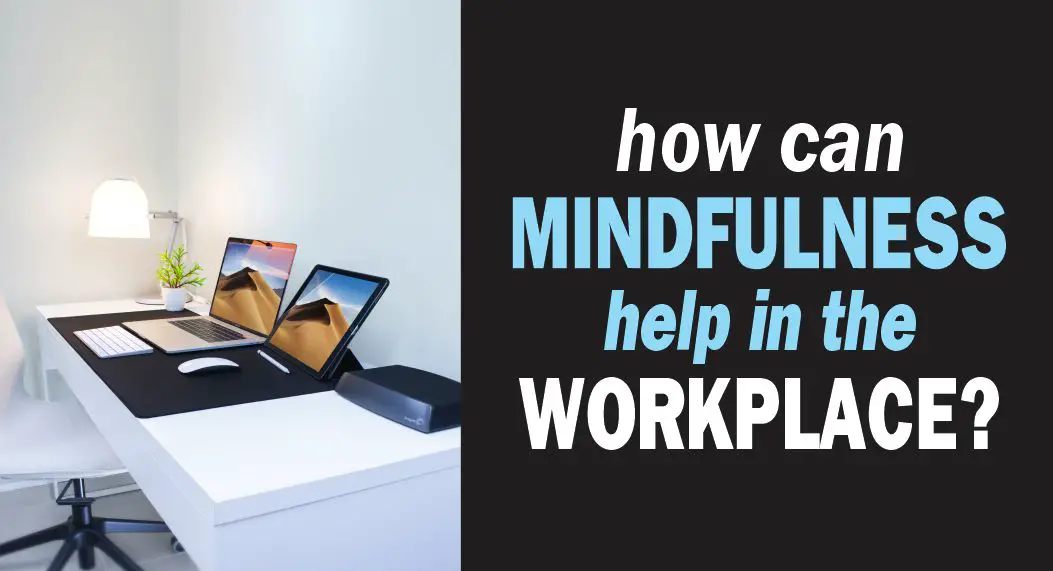Last updated on December 7th, 2025 at 06:55 pm
Practicing mindfulness in the workplace is becoming popular as people recognize its benefits. How can mindfulness help in the workplace?
This practice is known to improve focus, reduce stress and anxiety, and promote a sense of calm and well-being in the workplace.
Incorporating mindful concentration into your workday can mean taking breaks to breathe deeply, meditating, or simply taking a few minutes to observe your thoughts.
This can help you avoid feeling overwhelmed by a busy schedule or constant distractions.
Techniques like taking breaks and allowing yourself to be present in the moment improve your productivity and mental well-being.
Related: Mindfulness Routine Every Adult Should Know
Table of Contents
- What is Mindfulness in the Workplace?
- Benefits of Mindfulness in the Workplace
- How to Implement Mindfulness in the Workplace
- Examples of Companies that Adopt Mindfulness in the Workplace?
- Challenges and Obstacles in Practicing Mindfulness in the Workplace
- Frequently Asked Questions
- Conclusion
What is Mindfulness in the Workplace?
Mindfulness in the workplace is the practice of being fully present and engaged in your work activities, while also cultivating a sense of awareness and perspective about your thoughts, emotions, and surroundings.
It involves paying attention to what is happening at the moment, without judgment, and being conscious of your actions and reactions in the workplace.
Through mindfulness, you can develop greater focus, productivity, and creativity, while also reducing stress and increasing overall well-being.
It’s an opportunity to slow down, pause, and tune in to yourself and your surroundings, leading to more effective communication, decision-making, and work relationships.
Read: The Seven Pillars of Mindfulness
Benefits of Mindfulness in the Workplace

In today’s modern world, the workplace can be a stressful, busy, and demanding environment.
Below are the benefits of practicing mindfulness:
1. Mindfulness Reduces Stress
Stress in the workplace can lead to a variety of health problems, including high blood pressure, anxiety, depression, and heart disease.
Implementing mindfulness practices at work can help reduce stress levels and improve overall health and well-being.
2. Mindfulness Enhances Communication
In the workplace, effective communication is key. Mindfulness helps to improve communication by helping you to be more present and aware.
When you practice mindfulness, you will be better able to listen and respond to your colleagues, clients, and customers.
As a result, you’ll be better equipped to handle disagreements and conflicts professionally and productively.
3. Mindfulness Boosts Productivity
When you’re mindful, you’re able to stay focused and productive for longer periods.
Mindfulness helps you to manage distractions, avoid procrastination, and focus on the task at hand.
Incorporating mindfulness practices into your daily routine can help you to be more productive and efficient in your work.
4. Mindfulness Improves Decision-Making
Making decisions in the workplace can be challenging, especially when under pressure.
Mindfulness helps you to be more self-aware and make more informed decisions.
By taking time to be present and informed, you’ll be better able to evaluate options, weigh pros and cons, and make decisions that are aligned with your goals.
5. Mindfulness Enhances Work Satisfaction
Practicing mindfulness in the workplace can help you to enjoy your work more.
When you’re more focused, productive, and present, you’ll be better able to complete tasks efficiently, which can lead to greater job satisfaction.
Additionally, mindfulness helps to cultivate gratitude, which can lead to a more positive outlook on work and life.
How to Implement Mindfulness in the Workplace

Implementing mindfulness in the workplace can be easy in some environments while difficult in others.
Picture this: you’re in your office, staring at your computer screen, typing away furiously on your keyboard.
Your boss has just handed you a stack of files to go through, and the deadlines are quickly approaching.
Your mind is racing, your heart is pounding, and you can feel the overwhelming stress and anxiety building up inside of you.
Let’s take a closer look at how you can have a grip on all of that:
1. Take a Break in Your Workplace
First and foremost, take a break! Yes, you heard me right.
Stepping away from your desk and taking a few minutes to clear your mind can do wonders for your mental health and productivity.
Whether it’s taking a quick walk around the office, meditating in a quiet room, or simply taking a few deep breaths, a mini-break can help you refocus and recharge.
2. Gratitude in the Workplace
Another great tip for incorporating mindfulness in the workplace is to practice gratitude.
Whenever things get tough, take a moment to appreciate the good things in your life.
Maybe it’s a supportive co-worker, a delicious lunch, or a comfortable chair.
Whatever it is, acknowledging the positive things in your life can help boost your mood and keep you in a positive mindset.
Suggested: Tips to Overcome Negative Self-talk
3. Practice Mindfulness in the Workplace Throughout the Day
In addition to gratitude, practicing mindfulness throughout the day can also help reduce stress and increase productivity.
Endeavour to stay present in the moment and avoid distraction while focusing on the task at hand. Avoid multitasking and its dangers and stay focused on one thing at a time.
By practicing mindfulness in small ways throughout the day, you can build up your mental resilience and handle stress more effectively.
4. Mindful Breathing Exercises
Mindful breathing exercises are a type of meditation that involves focusing on the breath as a way to calm the mind and increase awareness.
This technique can be practiced anywhere, including the workplace.
By taking a few minutes throughout the day to engage in mindful breathing exercises, individuals can cultivate a greater sense of mindfulness and reduce stress and anxiety in the workplace.
5. Mindful Listening and Communication
To combat workplace overwhelm, practice mindful listening and communication.
By actively listening and expressing yourself clearly, you can improve relationships with coworkers, reduce stress, and increase productivity.
Taking the time to communicate mindfully can have a positive impact on your work environment.
6. Mindfulness Movement and Stretching
Mindfulness movement and stretching are great ways to enhance your mindfulness in the workplace!
Here’s how it works: whenever you start feeling stressed or overwhelmed, take a few minutes to do some simple stretching exercises or a bit of gentle movement.
This can help you release tension and clear your mind, providing an opportunity to refocus and re-energize.
Not only is it great for your physical health, but it can also help you stay present and grounded in the moment.
So, give it a try next time you’re feeling frazzled – your body and mind will thank you!
7. Mindful Work Environment
Creating a mindful work environment, such as decluttering, adding plants, and playing calming music, can reduce stress and improve productivity.
Incorporating mindfulness activities like stretching, aromatherapy, and mental check-ins throughout the day can contribute to a peaceful and focused work atmosphere.
Small changes can lead to a happier and more positive work experience.
Related: Tips on Mindfulness Meditation For Beginners
Examples of Companies that Adopt Mindfulness in the Workplace?

- Google: Google is one of the early adopters of mindfulness practice in the workplace. The company offers a program called “Search Inside Yourself,” a mindfulness-based emotional literacy training program designed to enhance focus, creativity, and compassion among employees.
- Aetna: Aetna, a healthcare company, offers mindfulness training to its employees through a program called “Mindfulness at Work.” The program aims to alleviate stress, improve focus, and boost productivity.
- General Mills: General Mills, a food processing company, introduced a mindfulness program called “Mindful Leadership” in the workplace to enhance the well-being and performance of its employees. The program includes meditation and mindfulness training to help employees find work-life balance.
- U.S. Marines: The U.S. Marines have incorporated mindfulness training in their boot camps to improve their attention, focus, and adaptability in high-stress situations.
- Chevron: Chevron introduced mindfulness training called “Mindful Energy” to help employees manage stress, enhance resilience, and improve productivity. The program includes mindfulness-based practices such as meditation, yoga, and deep breathing exercises.
- Harvard University: Harvard University has incorporated mindfulness training called “Mindfulness at Harvard” into its curriculum to help students manage academic stress, increase resilience, and promote well-being. The program includes meditation, mindfulness-based stress reduction techniques, and other mindfulness practices.
Challenges and Obstacles in Practicing Mindfulness in the Workplace

While it is easy to implement mindfulness in your personal life, practicing mindfulness in the workplace can be challenging with a unique set of obstacles.
Here are some of the challenges and obstacles that you might encounter while practicing mindfulness in the workplace:
1. Distractions and Interruptions
The workplace is filled with distractions and interruptions, from loud conversations to a steady stream of emails and notifications.
These distractions interrupt your focus and can make it challenging to maintain a mindful state of awareness.
It’s essential to find ways to minimize these distractions, whether that means closing your office door, finding a quiet corner to work, or setting boundaries with your colleagues.
2. Time Constraints
In today’s fast-paced workplace, time is a precious commodity, and mindfulness takes time and effort.
It can be challenging to carve out time to practice mindfulness when competing demands are vying for your attention.
However, it’s important to remember that practicing mindfulness will increase your productivity, and focus and help prevent burnout in the long run.
3. Unsupportive Workplace Culture
While some workplaces have embraced mindfulness with open arms, others are less supportive or even dismissive of this practice.
In a workplace that doesn’t prioritize mindfulness, adhering to your routine can feel like an uphill battle.
The only way to overcome this challenge is to lead by example and show the positive effects of mindfulness on your personal and professional life.
4. Judgmental Colleagues
Some coworkers may not take your mindfulness practice seriously, which can be demotivating.
They might perceive mindfulness as a waste of time or treat it as a trend that will soon fade away.
It’s crucial to ensure you don’t get discouraged and continue practicing regardless of their perception.
5. Difficulty Maintaining Consistency
Consistency is key when it comes to mindfulness practice, and the workplace can throw up various obstacles that make it hard to adhere to your routine.
Meetings, deadlines, and a myriad of other tasks can suck up your time and, consequently, make scheduling mindfulness practice challenging.
The key here is to remain flexible and adaptable, trying different times and environments that work for you.
Frequently Asked Questions
How can mindfulness be used in the workplace?
Mindfulness in the workplace involves being present, focused, and aware of your thoughts and actions, leading to better decision-making, reduced stress, and improved communication.
Why is it important to be mindful of your behavior in the workplace?
Being mindful of your behaviour in the workplace is important to maintain a positive work environment, encourage good relationships with colleagues, and avoid unnecessary conflicts or misunderstandings.
What is mindfulness in HR?
Mindfulness in HR involves incorporating practices like meditation, self-awareness, and emotional intelligence into HR policies and processes to promote employee well-being and satisfaction.
How can mindfulness be applied to teams?
Mindfulness can be applied to teams through practices like group meditation, open communication, active listening, and conflict-resolution techniques to enhance team cohesion, productivity, and creativity.
Conclusion
Integrating mindfulness in the workplace can greatly benefit employees and employers alike.
By taking the time to focus on the present moment and cultivating a non-judgmental attitude, employees can improve their mental clarity, emotional resilience, and overall well-being.
This can lead to increased productivity, creativity, and job satisfaction.
So if you’re looking to bring more peace and productivity into your workplace, give mindfulness a try!
References:
- What Are the Benefits of Mindfulness in the Workplace?
- Mindfulness at work: what are the benefits?
- What is mindfulness and why is it important in the workplace?
- 10 Ways to Be More Mindful at Work
Pyo Merez (PsyD) is a distinguished adolescent and adult psychologist at the forefront of mental health advocacy.
With expertise in cognitive and developmental psychology, focusing on social relationships, cultural contexts, and individual differences, Pyo has dedicated his career to empowering adolescents and adults.
As a sought-after speaker and panelist, Pyo shares invaluable insights on issues affecting young people, contributing to a deeper understanding of mental health and well-being in today's society.

